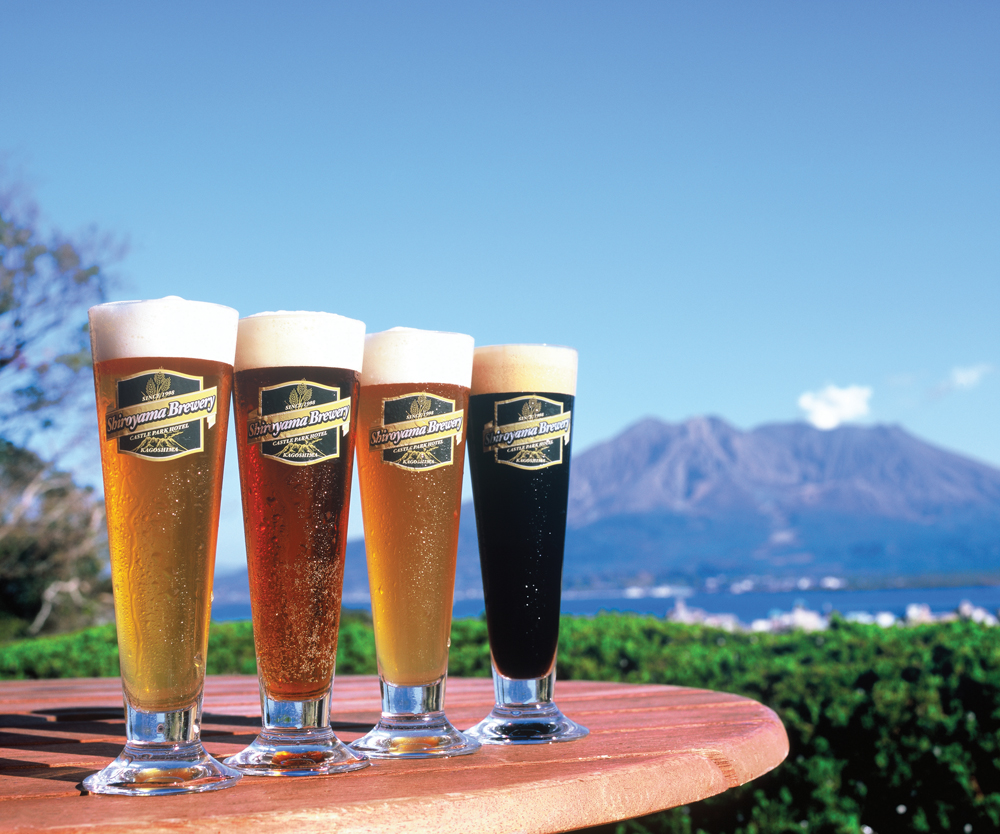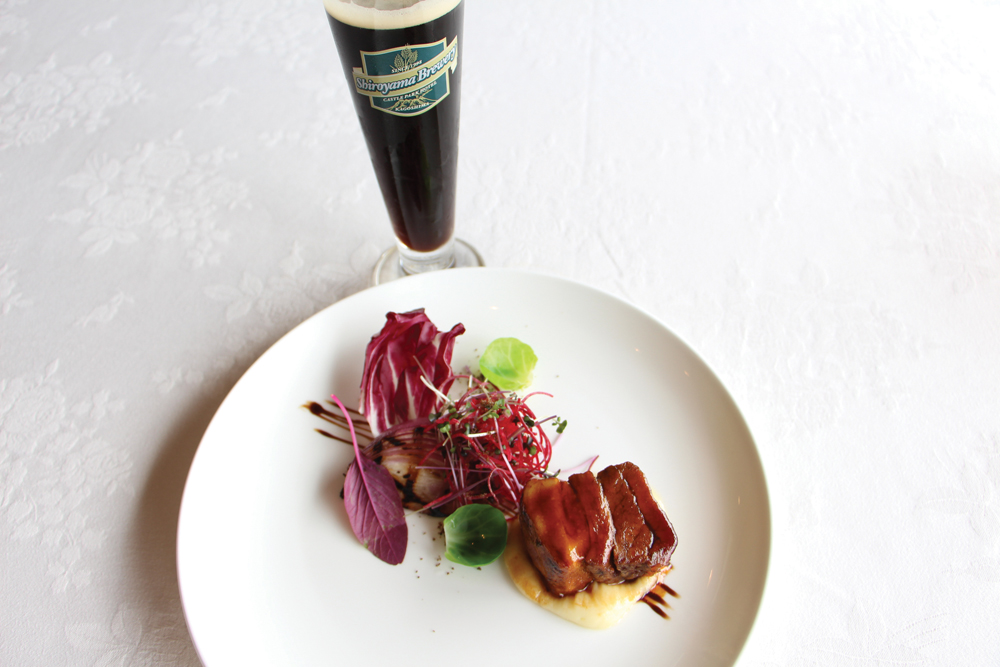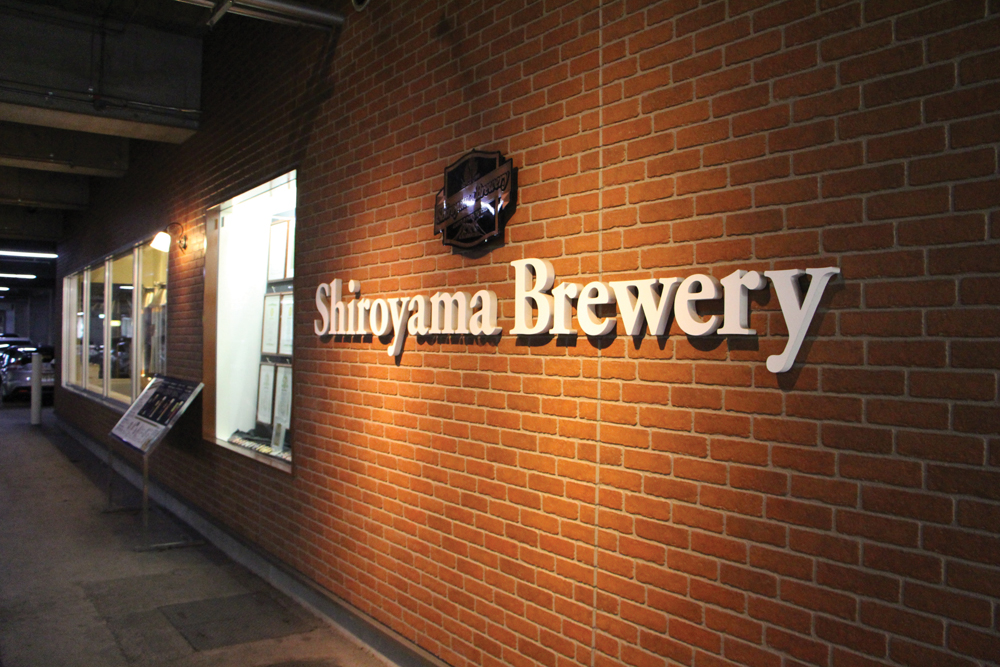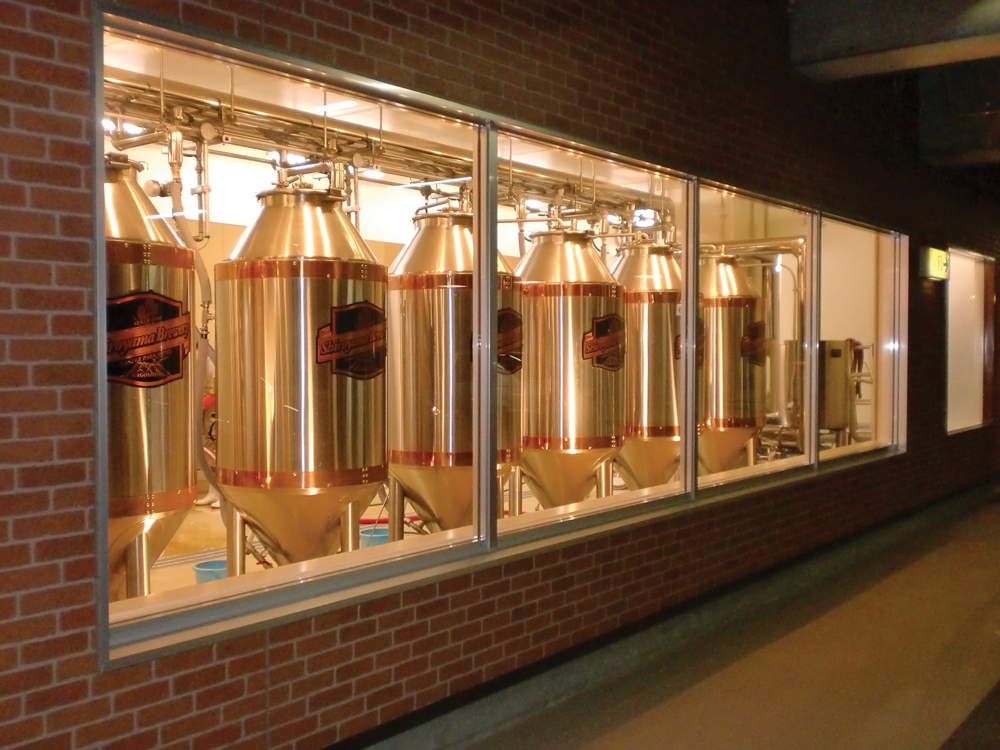Shiroyama sits right smack in the middle of Kagoshima City, where the Satsuma Rebellion came to its violent end in 1887. These days, Kagoshima’s premier lodging, the Shiroyama Kankô Hotel, occupies the spot and provides a home for Shiroyama Brewery.
The brewery was originally located in Fukuoka, inside of what was once the Hakata Shiroyama Hotel. Known then as the Hakata-Nakasu Brewery, it obtained its license in August of 1998 and launched September 10th.
The present brewmaster, Kurakake Tomoyuki, was a part of that launch in Fukuoka. When Kuarakake graduated from university and joined Shiroyama Kankô, he was first in charge of planning events for the company’s amusement grounds division. For events, yes, he sometimes had to wear furry costumes. When the amusement grounds closed, he worked for a while at a bowling alley, but then took the reigns of business operations at the Hakata Shiroyama Hotel where he ran lodging and banquets.
His role shifted again, to manager of the hotel’s liquor store, which marked a turning point. The company was launching its microbrewing operations and he happened to come across a fax saying that they were sending brewer-to-be to America for training. “I’d like to go to America again,” he thought—the “again” referring to the short period he spent there as an exchange student during his university years in Portland, Oregon, known around the world for its robust craft beer scene. He hated beer at the time but that all changed when he had his first sip of Henry Weinhard’s brand beer. He had no problems imbibing after that.
With a window of opportunity to go to America open, he begged his boss to send him, but was turned down: “We’ve already got someone.” He was at least able to join the brewery team. He first traveled to Isekadoya in May of 1998 where he lived and trained for a month. Kurakake notes, “From those connections, I was able to grasp the basic flow of the brewing process.” The Hakata-Nakasu Brewery opened later that year with an initial lineup that included lemon grass, Belgian white, stout, aloe, apricot and raspberry beers.
Interestingly, the person that followed in Kurakake’s footsteps for training at Isekadoya was none other than Shibata Yasuhiko of Onidensetsu in Noboribetsu, Hokkaido. When you try Isekadoya, Onidensetsu and Shiroyama’s pale ale, you’ll discover that there’s a similar crispness as well as hop aroma and bitterness. Influences of technique are very much apparent, demonstrating one of those interesting angles of craft beer.
There was a problem, however, with the brewing equipment being located in the hotel. It was right beside the front lobby and steam from an open boil would waft through with its aroma of wort and hop. Hotel guests wouldn’t know what to think, so Kurakake couldn’t employ the brewing techniques he had learned at Isekadoya. Looking back, Kurakake muses, “Our brewery now is not big at all, but that place back in Nakasu was tiny.”
Kurakake finally did get to return to America in 2002 on an eleven-day trip to Seattle, Denver, Sacramento, San Francisco and Los Angeles. At Wynkoop in Denver, he was given a big welcome and generous tour of the brewery, including a careful explanation of what yeast they used for each style.
Unfortunately, Hakata Shiroyama Hotel closed in September of 2009, but the company transferred the brewing equipment to the Shiroyama Kankô Hotel in Kagoshima and relaunched. By this point, the brewery had already received a permanent license so shifting operations to a new location went relatively smoothly. The doors reopened on April 23rd of that year and building from knowledge he had gained at Denver’s Wyncoop brewery, Kurakake made the leap from dry yeast to different kinds of liquid yeast appropriate to each style.
Overseas, he had also learned some dry-hopping techniques. Normally, dry-hopping with whole hops takes about two weeks, but he learned a way to do it with pellets requiring just six to eight hours. He also picked up some advice on milling his roast malt in a way that would elicit richer flavor.
Kurakake was brimming with ambition and creative ideas for brewing beer. Having already brewed successfully with fruits and spices, his next accomplishment was an 8%-alcohol Scotch ale with honey for his regular lineup.
In 2006 Kurakake decided to jump into the Valentine’s Day game where department stores and online gift retailers in particular offer sets of chocolate beer. With great enthusiasm, he even prepared a stout using chocolate malt for market. This beer, however, also used black sugar, which competed with the chocolate notes so he didn’t follow through. He regrouped and set his sights on White Day a month later (a Japanese ‘holiday’ born of marketing where men are supposed to return the favor of chocolates to women who traditionally give on Valentine’s Day). Kurakake’s answer was his Belgian White, which was met with great approval.
This beer that followed in the same style as its name used Sakurajima Mikan as a substitute for the orange peel typical of this style. This fruit native to the area is generally harvested between mid December and mid January. Kurakake needed as much as 25kg of peels for this brew and ended up eating mikan with every meal during this period to save up on them. Talk about a hand-crafted brew! In addition to these peels, he scrounged for additional fresh additives from the hotel restaurant and stored his ingredients in pouches in the freezer.
This past autumn the brewery debuted its limited-release Maazaku. This is the common name for the healthy herb chômeisô, produced on nearby Tokunoshima island. It was an IPA by style, but infused with this herb. The beer has subdued aroma and flavor definitely like an IPA with plenty of hops, albeit complemented with healthy herb flavor. This winter, Kurakabe intends to try his hand at another limited release in the Trappist style.
Kurakake was joined by fellow brewer Nishimura Yoritaka in August, 2013. Nishimura previously worked as the head brewer at Satsuma Beer (now shuttered) and is a veteran of brewing, having worked for twenty years from age 18.
They currently produce only 30 kiloliters a year, but compared to when they relaunched in 2004, that’s a fourfold increase. They are nearly at capacity at their little brewery, too. “Now that I think about it, I had plenty of free time years ago,” laughs Kurakake. You can further taste change in the beer, in all the technical knowledge he has gained. “I want to keep brewing beers that put smiles on the faces of customers when they drink it,” he continues. If anything can keep the smiles on people’s faces, it’s Kurakake’s beer. He always seems to be wearing a smile himself. Maybe it’s because he’s always drinking his own beer.
You can drink Shiroyama’s brews at select beer pubs in Tokyo and Osaka, but naturally you should stay at Shiroyama Kankô Hotel at least once and have a drinking session at the restaurant. The views from the hotel’s hot spring baths of Sakurajima are expansive and, best of all, there’s a beer server nearby when you get out.
This article was published in Japan Beer Times # () and is among the limited content available online. Order your copy through our online shop or download the digital version from the iTunes store to access the full contents of this issue.







